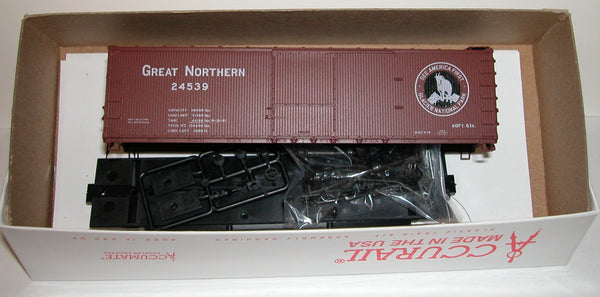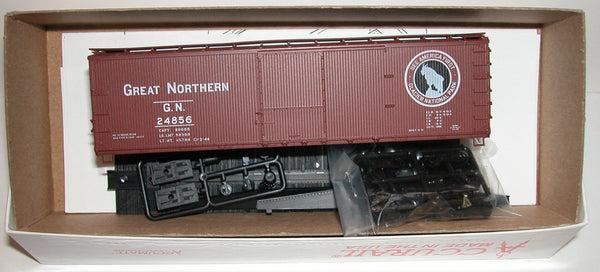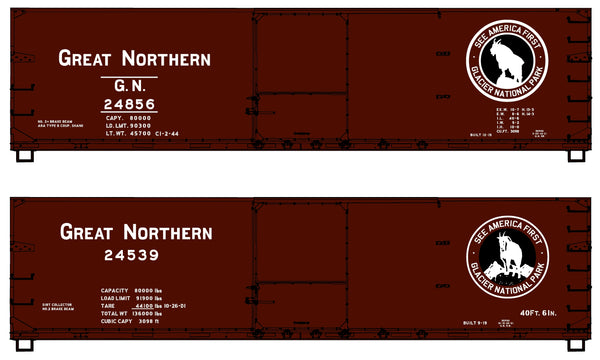B2 40 foot USRA box car
USRA 40 foot box car HO kit with trucks and magnetic couplers.
Forty-foot boxcars, and their 33 and 36-foot long predecessors, dominated the Great Northern’s car fleet for decades. They were used to haul anything that had to be protected from the weather. Grain was the traffic that paid the GN’s bills and grain was hauled in boxcars. Grain originated from Montana east of the Rocky Mountains eastward along the entire railway to the Minneapolis, and from central Montana and Eastern Washington to export elevators on the Lower Columbia River and Puget Sound. Lumber moved eastward from Washington, Oregon, Idaho, Montana in box cars. Lumber was long haul traffic that generated good revenue per carload. Less than Carload and carload merchandise was an important commodity group due to its high revenue. Boxcar loads of merchandise moved predominately westward on the GN.
Great Northern began to build its fleet of 40-foot box cars at the turn of the Twentieth Century. By 1917 the railway had purchased 22,666 40-foot wooden underframe box cars of 80,000 pound and 2,687 cubic feet capacity. Of these, 8,860 had drop bottoms for transportation of bulk coal. Side doors were 5’ 5” wide.
After the United States entered WW I in April 1917, American producers flooded the ports of New York and New Jersey with supplies for England and France much faster than water carriers could remove them. Up to 180,000 cars, including many tens of thousands of boxcars, plugged the ports and the rail lines leading to them as far west at Pittsburg and Buffalo, creating a car shortage in the rest of the country. Rather than help unclog the ports, the Federal Government took over the railroads and created a new bureaucracy, the USRA, on December 26, 1917, to operate them.
The new political bosses decided that, to simplify production of new equipment, the railroads should purchase only standard designs, which the politicians would create by calling together several committees of experts from private industry who, by the time the war was over on November 11, 1918, developed a series of USRA standard designs of cars and engines.
Great Northern received 1,500 USRA box cars built by Mt. Vernon Car in 1919, numbered 23494 to 24993. These were the GN’s first steel under fame box cars and in that feature were a step forward. They provided 80,000 pounds of carrying capacity and 3098 cubic feet of space. They had metal ends that were three steel panels, each with 5 ribs and metal roofs. Inside length was 40’ 6” compared to GN’s previous cars that were 40’ IL. Doors were 6’ wide rather than GN’s previous 5’ 5” standard. The fish belly under frames would prove to be heavier than the competing built up channel frame designs and fell out of favor during the 1920s. The 40’ 6” IL and six-foot-wide doors would become GN and industry standard dimensions until the end of production of 40-foot box cars.
After being returned to its owners and managers in 1920, the Great Northern bought 1,000 ‘USRA clones’ from Pullman in 1923, and in 1924-25 bought 600 under frames from Pullman and built bodies for them at St. Cloud. Clones are distinguished from USRA cars by the fact that the clones have 7 + 8 Murphy corrugated ends, rather than the 5-5-5 pattern of the USRA cars.
The model is Accurail’s 4600 series USRA box car custom painted for the Company Store.
We offer two paint styles, the Front Facing Goat, applied from 1926 to late 1940, and the Side Facing Goat applied from late 1940 through 1956. The car with the front facing goat is a rare combination of elements applied only in 1926. These cars come with molded on AB brakes, which are appropriate for the side facing Goat, but the front facing goat car should be back dated a bit by installing K brakes for maximum accuracy.
GNRHS Reference Sheet 42 and 408.






